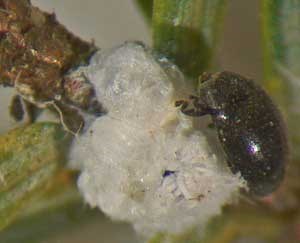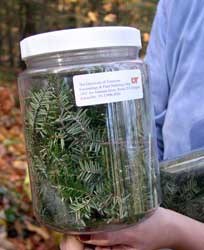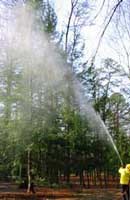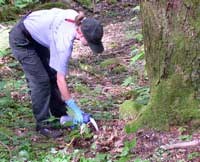
NPS photo. Using biocontrol to stop the spread of hemlock woolly adelgid The hemlock woolly adelgid (HWA), an invasive insect from Asia, has wreaked havoc on many of the hemlock forests in the eastern United States. Large populations of adelgids can kill a tree within two to four years. What are we doing to treat the hemlocks? Scientists first discovered hemlock woolly adelgids in Great Smoky Mountains National Park in 2002. Since then, Park Foresters have worked to save hemlocks using these three methods:
They have released over half a million biocontrol beetles to treat 250,000 trees in 100 hemlock conservation areas. Watch the PODCAST of a beetle release in Cataloochee. You can also read more about the history of the adelgids and chemical treatments in the Park, then use the back arrow to return to this page. 
NPS photo. Beetle backgrounds: Beetles to be released are born and raised at the Lindsay Young Beneficial Insects Lab at the University of Tennessee. Laricobius nigrinus (affectionately dubbed “Larry”), is featured in the upcoming podcast. This species is native to the Northwestern United States, where it feeds on adelgid species from that area. The other species the lab raises are Laricobius osakensis and Sasajiscymnus tsugae (or ST) from Asia and Scymnus coniferarum from the Northwestern United States. The latter two species are in the lady beetle family, although ST in particular resembles a black sesame seed more than the red and black spotted lady bug. Researchers drive the beetles from the lab in Knoxville to local protected lands: Great Smoky Mountains National Park, Frozen Head State Park, and the Cherokee National Forest. Each week during the beetle release season, one of these locations receives a small army of 300 beetles, which Park foresters and biologists place on understory hemlocks in the hopes that the insects will climb the “ladder” of plants to feed on HWA in the highest hemlock branches. 
NPS photo. Success? In 2005, managers began monitoring the health of treated versus untreated hemlocks. Here’s what they found:

NPS photo. Should homeowners use biocontrol beetles? According to Forestry Technician Jesse Webster, no. “The best, most effective [and] economical control of hemlock woolly adelgids,” he said, is “systemic treatment [such as soil drenching], not biological control with beetles.” Beetles work best in a huge forested landscape, because they work over several years as the beetle population grows and establishes itself. The most cost-efficient treatment for homeowners is soil-drenching with chemicals available at most hardware or garden supply stores, or from a private tree-treatment company. One place you can see the stark comparison between healthy and dying hemlocks is at Cataloochee, in the North Carolina section of the Park. This area is featured in the podcast that you can access above. Although 80% of this area was once logged to make way for apple orchards and hog farms, it is now lush green, with towering hemlocks, thick twisting arms of rhododendron, and tall patches of dog hobble. Vegetation managers began treating hemlocks here preventatively, and just a few years later, untreated stands are brittle grey. This emphasizes the importance of treatments. "If we can save just 20 percent of the hemlocks," Webster said, "our efforts will be worthwhile. Currently, there are thousands of healthy hemlocks located in multiple watersheds throughout the park, near trails, campgrounds, and further into the forest. With establishment of beetles in these areas, these forests will be here for future generations to enjoy." Return to Dying Giants main page. |
Last updated: May 18, 2021
